Are you a Quiet Speculation member?
If not, now is a perfect time to join up! Our powerful tools, breaking-news analysis, and exclusive Discord channel will make sure you stay up to date and ahead of the curve.
And now, back to our regularly scheduled metagame analysis. Let me just take a look at what's been winning... oh. MTGO's reporting system is bugged; there's been no new data since March 10. Huh. Ok, well, let me just see what's happening in the community... wait, really? Heliod Company is considered the best deck now? When did that happen?! The data that Wizards did manage to post clearly shows that Jund Shadow is Modern's best deck. Something's up here.
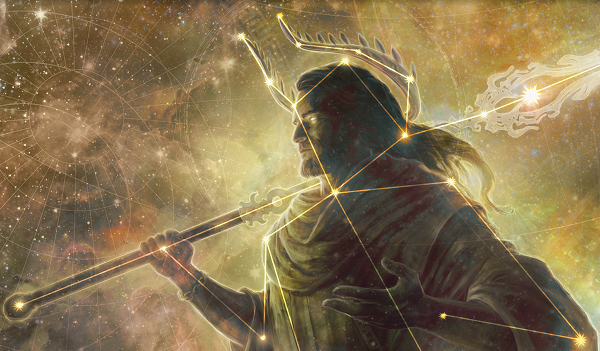
So, yeah, there's a new data crunch. As of writing, MTGO has not posted any decklists for almost two weeks. We're not totally deprived of data thanks to the work of redditor bamzing working twitter to get the results from Challenge-level events. However, there are no Preliminaries, so we're getting an incomplete metagame picture. Even by the past year's standards. And the narrative that I'm seeing everywhere is that Heliod Company is the best deck, which is a surprising turnaround. That deck has been hanging around Modern since Heliod, Sun-Crowned was printed, frequently though inconsistently in the top tiers. However, its average points were always abysmal, and below the baseline. Something has dramatically changed for it to be considered a bogeyman.
A Reality Check
I have to lead with the disclaimer that all the hype may be nothing. MTGO is a fairly small metagame because most players don't want to buy another collection for the limited payoff of playing online. Thus, the total population is smaller, which makes groupthink and/or circular metagaming easier. It is much easier to level yourself with smaller samples; if you know the likely competitors, know what they play, and plan to beat that, so long as they don't do the same 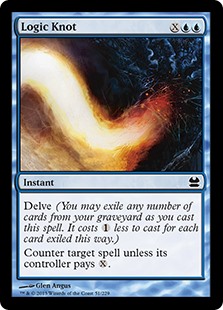 to you. Since the data from the limited source is further choked off, its much easier for weak observations to guide thinking and/or lead players astray. It may be that Heliod Company is the best deck right now. However, it may also be a self-fulfilling prophecy caused by MTGO players believing the hype or overthinking the metagame.
to you. Since the data from the limited source is further choked off, its much easier for weak observations to guide thinking and/or lead players astray. It may be that Heliod Company is the best deck right now. However, it may also be a self-fulfilling prophecy caused by MTGO players believing the hype or overthinking the metagame.
In other words, don't discount the possibility that right now Modern is chasing its own tail. Happened all the time on the Star City Games circuit. And MTGO is even more insular. I see the same names week after week in the Challenge results, and I don't think that's an accident. As such, whatever that group of very dedicated grinders thinks is happening is what will actually manifest in the results. I can't tell if the "real" metagame is actually defined by Heliod Company. Perusing League uploads suggests that red decks define the metagame. Thus, I'll be approaching this dive on Heliod Company with a critical skepticism.
The Latest Variation
Anyway, on to the deck in question. As mentioned, Heliod Company has been around a few months, and is just the latest variation on the theme of Collected Company Creature Compendium Combo decks which have been around for years. The deck has taken many forms in its history, sometimes as a major contender and sometimes as a forgotten deck. It's always been a deck of acceleration and medium (at best) creatures which intends to win via one of several combos and is held together by Company. And in a great many ways, that's still the case.
Heliod Company, PTarts2win (March NRG Modern Open, 2nd Place)
I'm actually almost glad that paper Magic isn't a thing because of this deck. Whenever Company is good, my LGS is overrun by it, and I don't usually play decks with good Company matchups. Last time it happened, I played Jeskai Control for months instead. It worked, but it's not how I like to play.
About the Deck
 Few decks have ever epitomized "the whole is greater than the sum of its parts" more than Company combo decks. While most of these creatures are at least reasonable Modern cards on their own (which is a first for the archetype), there's little to explain how it can hang with the likes of Izzet Prowess or Tron. What a lot of players forget is that Company is primarily a multi-combo deck. These decks contain multiple combo options for infinite life and infinite damage (and once upon a time, infinite mana via Devoted Druid and Vizier of Remedies). The trick is that this time, the combos require fewer parts.
Few decks have ever epitomized "the whole is greater than the sum of its parts" more than Company combo decks. While most of these creatures are at least reasonable Modern cards on their own (which is a first for the archetype), there's little to explain how it can hang with the likes of Izzet Prowess or Tron. What a lot of players forget is that Company is primarily a multi-combo deck. These decks contain multiple combo options for infinite life and infinite damage (and once upon a time, infinite mana via Devoted Druid and Vizier of Remedies). The trick is that this time, the combos require fewer parts.
Company started out having to assemble either Melira, Sylvok Outcast, Kitchen Finks/Murderous Redcap and Viscera Seer or sometimes Spike Feeder and Archangel of Thune. Vizier replaced Melira and created the mana combo so that a drawn Walking Ballista 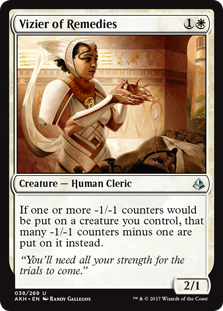 or a Duskwatch Recruiter to find the Ballista killed. Chord of Calling and Company were essential to actually make it all happen. The combos in Heliod Company all require just two cards, which is far easier to pull off. With Heliod out, Feeder goes infinite immediately. A Ballista with two counters given lifelink also kills with Heliod.
or a Duskwatch Recruiter to find the Ballista killed. Chord of Calling and Company were essential to actually make it all happen. The combos in Heliod Company all require just two cards, which is far easier to pull off. With Heliod out, Feeder goes infinite immediately. A Ballista with two counters given lifelink also kills with Heliod.
The biggest advantage is that Heliod is a +1/+1 counter engine by himself. Even if the combos don't happen, there are plenty of options to just use Heliod to build an army and win fairly. Conclave Mentor makes it easier and Company is always around to rebuild a board. Which would suggest that without Heliod, the deck just falls apart.
The Three Keys
However, that's easier said than done. The greatest strength of this iteration of Company is its creatures' survivability. All the critical creatures in previous versions died to Lightning Bolt. And while the non-Heliod combo pieces do still die to Bolt, the critical creatures don't. Even after sideboard, they're hard to answer. These are the true keys to Heliod Company's recent success.
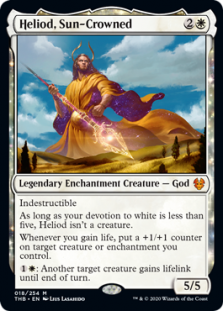 1) Heliod isn't usually a creature
1) Heliod isn't usually a creature
In the library, graveyard, hand, or on the stack, Heliod is a creature. However, on the battlefield, he's only a creature with five devotion to white. Even when he is a creature, he's indestructible. Consequently, there are very few answers to Heliod. The creature removal that works is Path to Exile, and I've noticed Company players being very careful with their devotion in matchups were Path is a consideration. And should that devotion count disappear (say, via Ranger-Captain of Eos being sacrificed), suddenly Path becomes irrelevant, and will fizzle if it was on the stack targeting Heliod. The God is therefore the rare engine card that isn't vulnerable to any commonly played removal. And thanks to indestructible, he's also not vulnerable to the typical sideboard enchantment removal. Heliod then gets to just hang around and threaten to combo off if the conditions are right. The only commonly played answer that unequivocally works is Skyclave Apparition.
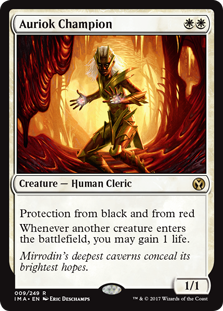 2) Maindeck Auriok Champion
2) Maindeck Auriok Champion
You know everything I said about Company being the glue holding the deck together? You can forget that; it applied to the older versions. The second-most important card in Heliod Company is Auriok Champion. The best Soul Sister may not be part of any infinite combo, but she's the best combo piece in the deck. She and Heliod combine to turn any creature (yours or the opponent's) into +1/+1 counters with no further input, growing the battlefield out of control with a speed often attributed to Humans. Plus, Champion has protection from the two main removal colors, which translates into an extremely sticky combo that simultaneously keeps you in the game (by gaining life) and making it harder for the opponent to win (Champion keeps getting counters). It's no quick combo, but its the best long-term plan for when it just isn't coming together.
Champion also makes those combos easier. The Ballista kill requires a total of six mana so that Ballista has two counters when it enters and Heliod can grant lifelink. Champion reduces that to four mana by providing the extra counter. Champion also provides an extra counter for Spike Feeder if Lava Dart is a concern. I'm actually retroactively surprised that Champion was not more integrated into previous versions, since it obviates the need for Kitchen Finks as lifegain.
 3) No Easy Sideboard Solutions
3) No Easy Sideboard Solutions
Finally, and again unlike previous versions, there's no silver bullet against Heliod Company. All the earlier versions relied on Company, Chord, and persist creatures, which meant that Grafdigger's Cage was backbreaking if left unanswered. Anger of the Gods wrecked the whole board and beat all the recursion Company used to run. With Heliod Company, independent of Apparition answering everything, there's no common sideboard card that's effective. Cage only hits Company; Anger of the Gods (which I loved against older versions) does nothing against Champion and Heliod; Aven Mindcensor only hits Ranger-Captain, which just searches for Ballista. No single card is half as effective against Heliod Company as Cage or Anger were, and that's helping to push up Company's numbers. Deicide, Wild Slash and Blightbeetle are seeing play just to have something against Company; that's how resistant the deck is to hate.
The Right Metagame
The final reason that Heliod has just exploded is that the metagame is ripe for it. Since the bannings, the format has been in flux. However, the red decks were largely unaffected, and having previously been top tier decks which now lacked a predator (Uro, specifically) Burn and Prowess made a play for dominance. And it worked, for a while. The problem is that there was a deck perfectly ready for them with 3-4 maindeck Auriok Champions and an 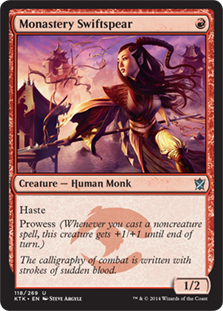 infinite life combo. Toward the end of February (the 25th if Apparition's price history is an indication), Heliod took off, feeding on all the red decks and began to move up the rankings.
infinite life combo. Toward the end of February (the 25th if Apparition's price history is an indication), Heliod took off, feeding on all the red decks and began to move up the rankings.
And the format continues to be favorable. The data I've collected puts Jund Shadow as the most played deck online (as of right now at least) with Burn at least Tier 2 and Prowess variants looking like strong choices. In fact, prior to the data problem, Company was a middling deck because it didn't show up in Preliminaries; just Challenges. With the only data being said Challenges, Heliod has closed the gap with Jund Shadow, as it puts large numbers in the Top 32. However, that's limited to the Challenges and the few outside events I've scrounged up (NRG series is a big one, but not the only one); the Heliod advantage isn't so clear. It still does well, but the total impact of all the red decks is far higher. In other words, there's ample prey for Company and it's taking advantage, whatever its inherent strengths.
Is There a Threat?
Of course, this being Modern, the question immediately becomes if there's a problem or not. 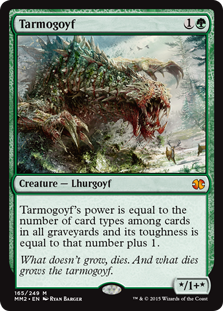 And my answer, as always, is that it's far too soon to say. There's not even clear evidence whether this is a real phenomena or just a quirk of the MTGO competitive crowd. However, if I were to pretend that Company's ascension is no accident or metagame fluctuation, my answer would still be no. Company is the kind of best deck that I like because it isn't just more value than everything else. It needs a lot to go right for it, and can be disrupted. Plus, its combo isn't necessarily game-ending: Tron and Infect don't care about infinite life, and the latter can win before Heliod more reliably. Death's Shadow went from Rakdos to Jund because Tarmogoyf is effective against Champion. Let's wait and see if Heliod survives the likely decline of red decks before breaking out the pitchforks.
And my answer, as always, is that it's far too soon to say. There's not even clear evidence whether this is a real phenomena or just a quirk of the MTGO competitive crowd. However, if I were to pretend that Company's ascension is no accident or metagame fluctuation, my answer would still be no. Company is the kind of best deck that I like because it isn't just more value than everything else. It needs a lot to go right for it, and can be disrupted. Plus, its combo isn't necessarily game-ending: Tron and Infect don't care about infinite life, and the latter can win before Heliod more reliably. Death's Shadow went from Rakdos to Jund because Tarmogoyf is effective against Champion. Let's wait and see if Heliod survives the likely decline of red decks before breaking out the pitchforks.
The Probable Solution
More importantly, even if Heliod Company is good, it has a natural predator that will hold it back. Remember how I said all the creatures are pretty medium? Company is still very vulnerable to dedicated anti-creature control. Moreso than before in many ways. Without Chord, there's no tutoring for Spellskite or Selfless Spirit, which makes spot removal and 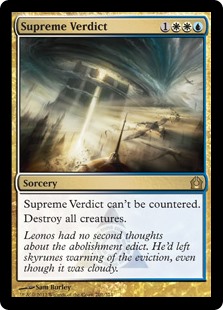 sweepers (besides Anger) far more effective than older version. Ranger-Captain may be a tutor, but its choices are mana dorks or Ballista. Not great for grinding. That isn't happening because the control decks seem to be more focused on each other than on killing creatures. If they go back to anti-creature configurations instead, Heliod will have a bad time.
sweepers (besides Anger) far more effective than older version. Ranger-Captain may be a tutor, but its choices are mana dorks or Ballista. Not great for grinding. That isn't happening because the control decks seem to be more focused on each other than on killing creatures. If they go back to anti-creature configurations instead, Heliod will have a bad time.
In the meantime, it's important to remember that Heliod is being carried by its namesake and Champion. Planning around those cards will pay more dividends than worrying about the various combos that are much harder to assemble now. Plus, the deck is generally underpowered, and a little slow. The right removal at the right time and a reliable gameplan will work better than trying to outsmart Heliod. I think we've forgotten how to deal with medium decks after the past few years, and that's helping Heliod.
There's Always Another Fish
There's nothing wrong with having a best deck in Modern. There's also nothing hard to indicate that Heliod Company actually is that best deck. For now, it appears that the Premier event metagame is wrapped around Heliod, so plan accordingly. For everyone not playing Premier events, I wouldn't worry. The Leagues still appear to be wide open and undefined.




